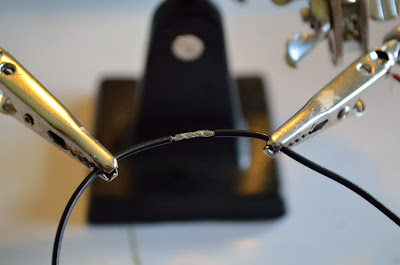Buy your own O2-kit here
 |
| Start with measuring all the resistors and labeling them. |
 |
| Smallest parts first, so solder all the small resistors like this. |
 |
| Add the diodes, make sure to solder them in the right direction!!! Solder the medium size resistors now too. |
 |
| The IC-sockets have such short legs to it's a good idea to add them early. |
 |
| Add the two big resistors at the bottom of the board. Keep 2-3mm distance between the resistors and the board since they can get warm during operation. |
 |
| Add some of the small capacitors. |
 |
| Add the slightly bigger capacitors on the bottom right of the board. |
 |
| Add the blue capacitors. |
 |
| Solder the LED first, it's important that you get it close to the board and pointing straight forward. Next att the 3.5mm sockets, they snap in to place so they are easy to solder. |
 |
| Add the power socket. Solder one leg first, reheat the joint and push it in place and then solder the remaining legs. |
 |
| Add the volume potentiometer, try it in the case with front panel on to make sure you put it in the right position. |
 |
| Volume control soldered to the board. For this kit I had to use the two row in the front. |
 |
| Now add the two round brown capacitors. |
 |
| Add the four big capacitors. Solder one leg first, push them in place and solder the rest. |
 |
| With battery connectors on board. I will be mounting an ODAC to the board so I only soldered the left pair. |
 |
| Don't use your expensive headphones the first time you are playing it. If something is wrong, you don't want to kill your $300 headphones. |













